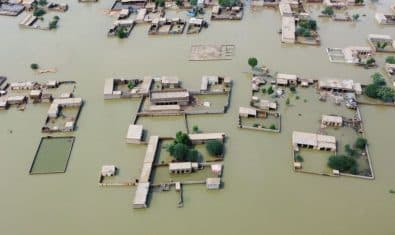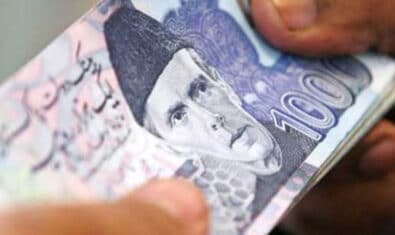Pakistan’s economy, which was relatively resilient in 2020, is forecast to experience a sluggish recovery in 2021, while foreign investors have not yet returned in significant volumes, says International Monetary Fund (IMF).
IMF, in its latest report titled “Regional Economic Outlook Update, Arising from the Pandemic: Building Forward Better,” stated that real GDP growth in the MENA region is projected to pick up to 4.0 percent in 2021, an upgrade of 0.9 percentage point relative to October. Growth is set to rebound slightly in Pakistan and strongly in Afghanistan in 2021 (1.5 percent and 4.0 percent, respectively).
Egypt and Pakistan’s economies, which were relatively resilient in 2020, are forecast to experience a sluggish recovery in 2021.
The report further noted that non-resident participation in local currency government debt markets remained negligible in most countries in the Middle East and Central Asia.
However, those exposed to short-term non-resident flows to local currency debt markets experienced substantial volatility during the year. Egypt and Pakistan saw heavy outflows as foreign investors exited their positions in domestic government securities during March-May (amounting to more than $15 billion and $2.5 billion, respectively).
ALSO READ
IMF Projects Pakistan’s Total Debt to Increase to 92.9% of GDP in 2021
In Egypt, prudent macroeconomic policies and high real yields supported the reversal of earlier outflows by year’s end, despite a 400-basis-point reduction in policy rates. In Pakistan, foreign investors have not yet returned in significant volumes.
Average public gross financing needs during 2021–22 are expected to remain higher than 15 percent of GDP in most of the Middle East and Central Asia’s emerging markets.
The median external debt amortization is low (about 4 percent of GDP), but rollover and refinancing risks of domestic debt are high, given the elevated domestic amortization in some countries, rising higher than 15 percent of GDP in Bahrain, Egypt, and Pakistan.
Assuming that the additional budgetary needs stemming from the simulated combined shocks are funded by domestic banks in addition to the net bank financing already covering the expected 2021–22 needs, four governments in the region (Egypt, Oman, Pakistan, and Tunisia) would absorb an additional 10 to 23 percent of banks’ assets as government debt during 2021–22.
Such a development would further intensify the banking sector’s exposure to the sovereign, potentially reducing banks’ capacity to lend to the private sector severely and likely weakening prospects for a sustainable and strong recovery, the report noted.
The 13 countries and territories in this group (Afghanistan, Algeria, Djibouti, Egypt, Iran, Iraq, Jordan, Lebanon, Libya, Pakistan, Tunisia, Uzbekistan, West Bank, and Gaza) started vaccinations with limited coverage and are generally not expected to inoculate a significant portion of their population until at least mid-2022, barring additional efforts, such as help from the international community.
It further noted that several countries with flexible exchange rates saw their currencies depreciating early in the pandemic (Armenia, Georgia, Kazakhstan, Kyrgyz Republic, Morocco, Pakistan, Tajikistan, Tunisia), and they have since partially reversed in some cases. To reduce excessive volatility, foreign exchange intervention occurred in a few cases (Armenia, Egypt, Georgia, Kazakhstan, and Pakistan).
By the end of August, most central banks had also cut their policy rates. After the end of August, five central banks, i.e., Armenia, Azerbaijan, Egypt, Tunisia, and Uzbekistan, cut rates further, ranging from 25 to 100 basis points. Total cuts were especially deep in Pakistan and Egypt, by a cumulative 625 and 400 basis points, respectively.
Workers’ remittances also held up better than expected. Flows rebounded in the third quarter of 2020 after a sizable drop in the second quarter, reflecting a combination of factors, including a broad improvement in the third-quarter growth in remittance-sending countries, an accelerated switch to formal transfer channels because of border closures, and incentives for electronic transfers (for example, Pakistan).
Corporations in the MENA region and Pakistan began recovering in the third-quarter of 2020 (after a historic contraction during the first half of the year) in an uneven manner, with contact-intensive sectors (particularly service and retail), smaller firms, and those that entered the pandemic with weaker fundamentals still not posting positive revenue growth.
ALSO READ
IMF Projects Average CPI Inflation at 8% in FY22
With the recovery underway, fiscal balances are expected to improve across the region because of higher revenues and the expiration of pandemic-related measures, and the resumption of the fiscal consolidation in some countries (for example, Egypt, Iraq, Jordan, Oman, and Pakistan) with elevated debt burdens.
Before the COVID-19 crisis, domestic banks’ exposure to the sovereign was above 20 percent of total banks’ assets in Iraq, Jordan, and Qatar, reaching above 45 percent in Algeria, Egypt, and Pakistan, and up to 60 percent in Lebanon. By contrast, banks in other emerging markets had a public sector exposure of about 12 percent.
Such an overexposure is detrimental for domestic debt market development, as well as for the government and the private sector to secure financing at the lowest possible cost among a diversified pool of creditors.
Similar to past trends, domestic banks played a key role in funding governments in 2020, covering more than 50 percent of public gross financing needs in Bahrain, Egypt, Jordan, Pakistan, and Tunisia.
Some countries relied heavily on shorter-term domestic financing, reflecting borrowing cost considerations and nascent domestic markets for long-term instruments (for example, Egypt and Pakistan), but others issued long-term domestic bonds and secured savings for years ahead (for example, Jordan and Morocco).






















Whom to believe? Under this news PTI’s economic spokesperson is celebrating strong economy and this news is telling us that we will have a very weak economic growth. Who is telling the real truth?.